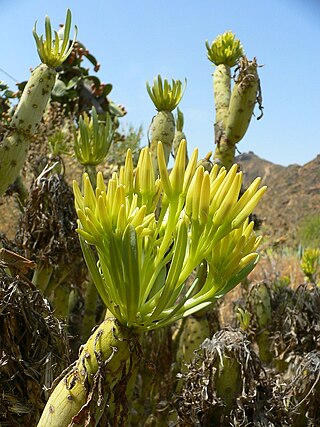
Senecio is a genus of flowering plants in the daisy family (Asteraceae) that includes ragworts and groundsels.

Senecio vulgaris, often known by the common names groundsel and old-man-in-the-spring, is a flowering plant in the family Asteraceae. It is an annual herb, native to the Palaearctic and widely naturalised as a ruderal species in suitable disturbed habitats worldwide.

Senecioneae is the largest tribe of the Asteraceae, or the sunflower family, comprising over 150 genera and over 3,500 species. Almost one-third of the species in this tribe are placed in the genus Senecio. Its members exhibit probably the widest possible range of form to be found in the entire plant kingdom, and include annuals, minute creeping alpines, herbaceous and evergreen perennials, shrubs, climbers, succulents, trees, and semi-aquatic plants.

Pericallis is a small genus of 15 species of flowering plants in the family Asteraceae, native to the Canary Islands, Madeira and Azores. The genus includes herbaceous plants and small subshrubs. In the past, the genus was often included in either Cineraria or Senecio.

Jacobaea maritima, commonly known as silver ragwort, is a perennial plant species in the genus Jacobaea in the family Asteraceae, native to the Mediterranean region. It was formerly placed in the genus Senecio, and is still widely referred to as Senecio cineraria; see the list of synonyms (right) for other names.
British NVC community MC5 is one of the maritime cliff communities in the British National Vegetation Classification system. It is one of five communities categorised as maritime cliff crevice and ledge communities.

Senecio eboracensis, the York groundsel or York radiate groundsel, is a flowering plant in the daisy family Asteraceae. It is a hybrid between a native and a non-native introduced species, which naturalised in England but the population failed to sustain itself. It was brought back by captive cultivation. It is a self-pollinating hybrid species of ragwort and one of only six new plant species to be discovered in either the United Kingdom or North America in the last 100 years.

Kleinia is a genus of African flowering plants in the sunflower family. Kleinia contains around 50 species and is distributed from the Canary Islands, throughout Tropical Africa to India and Arabia. It is closely related to the genus Senecio but is distinguished primarily by having succulent stems or leaves.

Senecio falklandicus, synonym Senecio littoralisGaudich., is a species of flowering plant in the family Asteraceae endemic to the Falkland Islands. It is known as the woolly ragwort. Its natural habitats are temperate shrubland, rocky areas, and rocky shores. This species is threatened by habitat loss.

Senecio angulatus, also known as creeping groundsel and Cape ivy, is a succulent flowering plant in the family Asteraceae that is native to South Africa. Cape ivy is a scrambling herb that can become an aggressive weed once established, making it an invasive species. It is grown as an ornamental plant for its satiny foliage and sweet-scented flowers.

Senecio tamoides, also known as Canary creeper, false grapevine, and parlor ivy, is a climbing member of the genus Senecio of the family Asteraceae that is native to Southern Africa. It is used as an ornamental plant for its showy yellow, daisy-like flowers in late autumn through to winter.

Senecio leucanthemifolius is a plant common in sea-side in Mediterranean area.

x Senecurio kleiniiformis is a hybrid species of flowering plant in family Asteraceae. It has been placed in either the genus Senecio, as Senecio × kleiniiformis, or Kleinia, but is now thought to be a hybrid between an unknown species of Curio and Senecio tropaeolifolius. It was initially named Curio × kleiniiformis, but in 2020 the hybrid genus Senecurio was created for it.

Senecio pinnatifolius is a species of herb native to Australia. Common names include coast groundsel, dune groundsel and variable groundsel.

Cape Lowland Freshwater Wetland is a critically endangered vegetation type of the Western Cape, South Africa.

Senecio glastifolius is a species of flowering plant in the aster family known by the common names woad-leaved ragwort, holly-leaved senecio, and pink ragwort. A tall perennial herb, it is endemic to the Cape Provinces of South Africa, and it is cultivated as an ornamental plant for its colorful flowers. It has been known to escape cultivation and become naturalized in areas of appropriate climate; it can be found growing wild in parts of New Zealand and Australia.
Senecio leucadendron is a species of flowering plant in the family Asteraceae, endemic to Saint Helena. It was first described by Georg Forster in 1789 as Solidago leucadendron.
Senecio argutus is a species of flowering plant in the family Asteraceae, native to Mexico. It was first described by Carl Sigismund Kunth in 1818.














